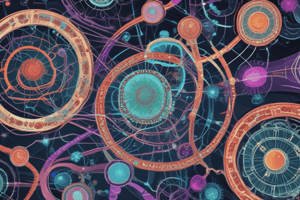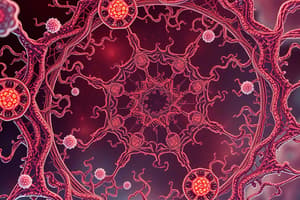Podcast
Questions and Answers
Which of the following is the MOST accurate description of cell differentiation?
Which of the following is the MOST accurate description of cell differentiation?
- The process by which cells transport different molecules across their membranes.
- The process by which cells become specialized for specific functions. (correct)
- The process by which cells randomly change their structure.
- The process by which cells divide rapidly to increase in numbers.
Why is genetic variation important for sexually reproducing organisms?
Why is genetic variation important for sexually reproducing organisms?
- It ensures that all offspring are perfectly suited to their current environment.
- It keeps the population genetically identical and stable.
- It reduces the likelihood of offspring inheriting harmful mutations.
- It enhances the ability of a population to adapt to environmental changes and resist diseases. (correct)
What is the key ethical concern associated with the use of embryonic stem cells?
What is the key ethical concern associated with the use of embryonic stem cells?
- They can only be derived from animal sources, raising ethical issues about animal welfare.
- The destruction of an embryo is often involved in obtaining them. (correct)
- Their use is strictly regulated by international laws.
- They are difficult to differentiate into specific cell types.
What process reduces the chromosome number from diploid to haploid?
What process reduces the chromosome number from diploid to haploid?
What is the primary significance of crossing over during meiosis?
What is the primary significance of crossing over during meiosis?
Which of the following BEST describes gene linkage?
Which of the following BEST describes gene linkage?
What is the key characteristic of a zygote immediately after fertilization?
What is the key characteristic of a zygote immediately after fertilization?
Why is C. elegans used as a model organism for studying differentiation?
Why is C. elegans used as a model organism for studying differentiation?
How do induced pluripotent stem cells (iPS cells) differ from embryonic stem cells?
How do induced pluripotent stem cells (iPS cells) differ from embryonic stem cells?
What is the end result of meiosis in a diploid cell?
What is the end result of meiosis in a diploid cell?
What is the primary function of internal regulatory proteins?
What is the primary function of internal regulatory proteins?
What distinguishes malignant tumors from benign tumors?
What distinguishes malignant tumors from benign tumors?
What is the role of growth factors in the cell cycle?
What is the role of growth factors in the cell cycle?
How do neighboring cells influence the cell cycle?
How do neighboring cells influence the cell cycle?
What can cause defects in the genes that control the cell cycle?
What can cause defects in the genes that control the cell cycle?
What is a characteristic behavior of cancer cells compared to normal cells?
What is a characteristic behavior of cancer cells compared to normal cells?
Why are cancer cells particularly vulnerable to radiation treatment?
Why are cancer cells particularly vulnerable to radiation treatment?
What is the function of the p53 gene in relation to cancer?
What is the function of the p53 gene in relation to cancer?
Flashcards
Differentiation
Differentiation
The process by which cells specialize for specific functions in the body.
Zygote
Zygote
A fertilized egg that is totipotent and can develop into any cell type.
Induced pluripotent stem cells (iPS cells)
Induced pluripotent stem cells (iPS cells)
Cells created by converting somatic cells to resemble embryonic stem cells.
Meiosis
Meiosis
Signup and view all the flashcards
Diploid
Diploid
Signup and view all the flashcards
Haploid
Haploid
Signup and view all the flashcards
Crossing over
Crossing over
Signup and view all the flashcards
Genetic variation
Genetic variation
Signup and view all the flashcards
Gene linkage
Gene linkage
Signup and view all the flashcards
Gametes
Gametes
Signup and view all the flashcards
Cell Cycle Controls
Cell Cycle Controls
Signup and view all the flashcards
Internal Regulators
Internal Regulators
Signup and view all the flashcards
p53 Gene
p53 Gene
Signup and view all the flashcards
External Regulators
External Regulators
Signup and view all the flashcards
Cancer
Cancer
Signup and view all the flashcards
Benign vs Malignant Tumors
Benign vs Malignant Tumors
Signup and view all the flashcards
p53's Role in Cancer
p53's Role in Cancer
Signup and view all the flashcards
Localized Cancer Treatments
Localized Cancer Treatments
Signup and view all the flashcards
Study Notes
Cell Growth and Division Controls
- Cell growth and division are regulated by proteins and checkpoints in the cell cycle.
- Internal regulators respond to events inside the cell. Examples include p53, which prevents cell division with damaged DNA.
- External regulators respond to events outside the cell. Growth factors stimulate cell division.
- Neighboring cells can affect cell division via contact inhibition.
- Cancer is uncontrolled cell division, characterized by uncontrolled growth, lack of response to regulatory signals, and invasion of tissues.
- Tumors are masses of cancerous cells. Benign tumors are non-cancerous; malignant ones are cancerous and spread.
- Defects in cell cycle genes can be caused by mutations, environmental factors, or carcinogens.
Cancer and its Treatment
- The p53 gene regulates the cell cycle and triggers apoptosis with DNA damage; mutations can cause cancer.
- Localized cancer can be treated through surgery, radiation therapy, or targeted therapies.
- Cancer cells are more susceptible to radiation due to their rapid division and reduced DNA repair capacity.
Cell Differentiation
- Differentiation is the specialization of cells for specific functions, crucial for complex organisms.
- A zygote is a fertilized egg, totipotent (capable of developing into any cell type).
- Induced pluripotent stem cells (iPS cells) are created by converting adult cells into stem cell-like cells. Ethical concerns surround the use of embryonic stem cells, often involving embryo destruction.
- Differentiation in multicellular organisms occurs through gene expression changes in precursor cells, leading to specialized cells. Examples include neurons, muscle cells, and red blood cells.
- C. elegans (a microscopic worm) is studied for differentiation due to its simple structure and well-documented cell lineage.
Cell Cycle and Mitosis
- Diploid cells have two sets of chromosomes (2n). Haploid cells have one set (1n). Gametes (sperm and egg) are haploid.
- Meiosis is the process reducing chromosomes from diploid to haploid (2n to 1n), forming four haploid cells from one diploid cell.
- Meiosis involves two divisions (Meiosis I and Meiosis II), with crossing over during prophase I of meiosis I.
- Crossing over during meiosis increases genetic variation.
- Genetic variation is crucial for adaptation and disease resistance in sexually reproducing organisms.
Gene Linkage
- Gene linkage describes genes located close together on the same chromosome and inheriting together, impacting inheritance patterns.
- Meiosis contributes to genetic diversity via processes such as crossing-over and independent assortment.
Studying That Suits You
Use AI to generate personalized quizzes and flashcards to suit your learning preferences.



